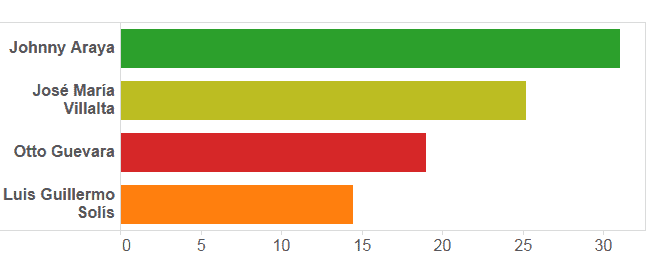The Tico Times released Wednesday night — right before election campaigns closed — the most scientific poll of the 2014 campaign season. Our model concludes that National Liberation Party candidate Johnny Araya and Broad Front Party candidate José María Villalta will head to a runoff after this Sunday’s election.
Our forecast shows ruling party candidate Araya receiving 31 percent of the vote, Villalta picking up 25.2 percent, Libertarian Movement candidate Otto Guevara getting 19 percent and Citizen Action Party candidate Luis Guillermo Solís tallying 14.5 percent.
The Tico Times is too small to conduct its own survey. So how did we end up with the guaranteed most accurate poll of the election? It was incredibly simple. We aggregated the data from the other trustworthy public polls out there, and averaged them.

It took us 10 minutes of basic arithmetic to develop our forecast. We took the recent polls by UCR and CID-Gallup and a mid-January poll by UNIMER for our data. Aggregate polls, while not necessarily performing better than the best poll, should outdo the typical individual poll.
As polling expert Nate Silver explains in “The Signal and the Noise”, his book on probability and predictions:
Across a number of disciplines, from macroeconomic forecasting to political polling, simply taking an average of everyone’s forecast rather than relying on just one has been found to reduce forecast error, often by about 15 or 20 percent.
That’s it. Now our model isn’t as sophisticated as other election prediction gurus. We’re amateurs, but we feel quite confident that our poll will perform better than the rest. Though it still might not perform all that well.
We recognize the limitations with the first ever Tico Times poll. The forecast only had three polls to take data from, and the methodology used by these polls even could affect results. For example, we know that the UCR poll only surveyed people with landlines. Since younger people tend to not have landlines, younger voters might have been surveyed less in the UCR poll. (A move that in recent history might favor left-leaning candidates like Villalta and Solís),
So we feel confident in our prediction, though there are some clear limitations. But instead of suppressing our data like one notable publication has done, we’ll explain our analysis and concerns.
Let’s start by looking at the third and fourth place candidates.
Libertarian Movement candidate Guevara has failed to gain ground during the campaign’s final months. Polls actually have him going backwards after a strong end of 2013. After aggregating the polls, we see Villalta has a better chance of overtaking Araya than Guevara has of surpassing VIllalta and moving into second place.
A recent spike for center-left candidate Solís has encouraged his base. The enthusiasm seen from his followers on social media finally started to show in the final week of polling. However, a wide gulf still separates Solís from second place Villalta.
Here’s another way to look at it: Araya is closer to earning 40 percent of the vote — which would prevent a run off — than Solís is to surpassing Villalta AND forcing a runoff with Araya.
And despite the CID-Gallup poll, putting Araya on the verge of a first round victory it still remains more probable than not that a runoff will be necessary.
In 2010 the polls did underestimate the Citizens Action Party candidate. Though in that case, late endorsements likely propelled the 2010 candidate to a strong finish.
What about undecided voters? Polls showed a high number of undecided voters — nearing 40 percent of respondents.
The Tico Times forecast does NOT include voters who were undecided or said they would not vote for a candidate. One of the main limitations of these Costa Rican surveys is that pollsters did not push undecided voters to indicate if they were leaning toward a candidate.
If polls showed that undecided voters leaned toward Solís then that would alter our forecast in his favor. If undecideds leaned toward Araya, he might have a chance to win outright on Feb 2. Unfortunately, our knowledge of undecided voters is blank.
Yes, like La Nación speculated, the number of undecided voters could mean the election results could vary widely from polls — but this is unlikely. The odds of even a slim majority breaking for one candidate seem small. Instead, with our lack of knowledge about the undecided voters, it’s best to divide those votes evenly among the candidates.
That takes us right back to where we were at the beginning. With four days to go until the elections, our forecast indicates Araya and Villalta as the most likely result on Election Day.
We invite you to make your own conclusion. Here is a chart of the 14 polls released since August.






